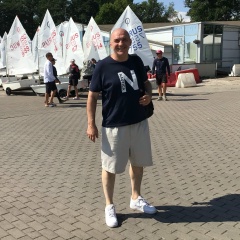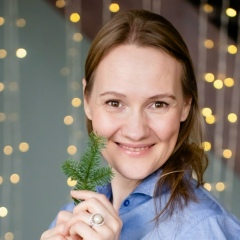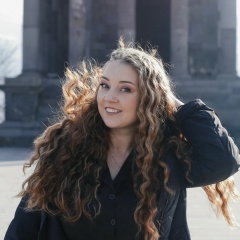Торжественное открытие Большого концертного зала «Октябрьский» состоялось осенью 1967 года. 25 октября прошел первый концерт для строителей БКЗ "Октябрьский". Главный концертный зал так и был назван - Большой концертный зал "Октябрьский".
Это сверкающее здание из стекла и солнечного сааремского доломита выросло в центре города недалеко от площади Восстания между Лиговским и Греческим проспектами (на Греческой площади). Его строгий современный облик удивительно гармонично вписался в классический ансамбль старинного Петербурга.
Зал, построенный по проекту группы архитекторов, возглавляемой А.В.Жуком, изначально создавался как аналог Кремлевского дворца съездов и предназначался для проведения торжественных заседаний, городских мероприятий и кинопросмотров.
***************************
Греческая площадь С 1788 по 1822 годы называлась Конной. До 1875 года называлась Летней Конной площадью. В те времена на этом месте летом торговали лошадьми
На месте старого здания касс БКЗ «Октябрьский» находился Песчаный мост через Лиговский канал (позднее он был засыпан)
Для постройки БКЗ «Октябрьский» была снесена Церковь Святого Великомученика Димитрия Солунского (при греческом посольстве — единственная греческая церковь в Санкт-Петербурге).
После Крымской войны греческая община количественно выросла. В результате, в конце 1850-х годов греки попросили предоставить место у Лиговского канала для строительства трёхпрестольного храма.
Для строительства храма городской администрацией по воле императора Александра II была предоставлена бывшая Летняя Конная площадь. Сразу после этого греческая община стала собирать средства на постройку храма. В связи с тем, что собранных денег было достаточно лишь на возведение часовни, грек-предприниматель Д. Е. Бенардаки предложил передать эти средства на возрождение русской посольской Троицкой церкви в Афинах, а строительство храма в Санкт-Петербурге взял на свой счёт.
Закладка храма во имя святого Димитрия Солунского состоялась 25 мая (6 июня) 1861 года. Церковь строилась по проекту архитектора Р. И. Кузьмина, долгое время прожившего в Греции. Одновременно с возведением храма предполагалось построить странноприимный дом.
31 октября (11 ноября) 1865 год митрополит Исидор (Никольский) освятил храм. На торжестве присутствовали министр иностранных дел князь А. М. Горчаков и греческий посол; члены общины были одеты в национальные костюмы. Ранее, 25 октября (6 ноября), был освящён нижний придел.
Богослужения в храме совершались на греческом и славянском языке. Церковь принадлежала греческому посольству. Долгое время регентом хора был композитор Брагин, написавший специально для церкви музыку к греческой литургии.
Торжественными памятными днями в храме считались: престольный праздник, царские дни греческого королевского дома и Благовещение Пресвятой Богородицы — день освобождения Греции от турок.
********************
В течение последних 10 лет петербуржцы ведут упорную борьбу за восстановление храма. В прошлом году к ней подключились «Фонд возрождения архитектурного облика русских городов» и все творческие союзы Петербурга. Под руководством фонда и Трудовой партии был организован общероссийский сбор подписей за возрождение Греческой церкви.
Церковь хотят строить там, где уже сейчас закладывают фундамент бизнес-центра. Но сами греки готовы идти на компромисс. Предлагают передвинуть стройку на пару метров в сторону. А храм сделать доминантой Лиговского проспекта. Восстановление храма сегодня уже активно поддерживают и в сети.
(UPD: В какой стадии ныне восстановление «русской Софии» ... я в сети не нашёл, а в современной ситуации это важный момент)
Это сверкающее здание из стекла и солнечного сааремского доломита выросло в центре города недалеко от площади Восстания между Лиговским и Греческим проспектами (на Греческой площади). Его строгий современный облик удивительно гармонично вписался в классический ансамбль старинного Петербурга.
Зал, построенный по проекту группы архитекторов, возглавляемой А.В.Жуком, изначально создавался как аналог Кремлевского дворца съездов и предназначался для проведения торжественных заседаний, городских мероприятий и кинопросмотров.
***************************
Греческая площадь С 1788 по 1822 годы называлась Конной. До 1875 года называлась Летней Конной площадью. В те времена на этом месте летом торговали лошадьми
На месте старого здания касс БКЗ «Октябрьский» находился Песчаный мост через Лиговский канал (позднее он был засыпан)
Для постройки БКЗ «Октябрьский» была снесена Церковь Святого Великомученика Димитрия Солунского (при греческом посольстве — единственная греческая церковь в Санкт-Петербурге).
После Крымской войны греческая община количественно выросла. В результате, в конце 1850-х годов греки попросили предоставить место у Лиговского канала для строительства трёхпрестольного храма.
Для строительства храма городской администрацией по воле императора Александра II была предоставлена бывшая Летняя Конная площадь. Сразу после этого греческая община стала собирать средства на постройку храма. В связи с тем, что собранных денег было достаточно лишь на возведение часовни, грек-предприниматель Д. Е. Бенардаки предложил передать эти средства на возрождение русской посольской Троицкой церкви в Афинах, а строительство храма в Санкт-Петербурге взял на свой счёт.
Закладка храма во имя святого Димитрия Солунского состоялась 25 мая (6 июня) 1861 года. Церковь строилась по проекту архитектора Р. И. Кузьмина, долгое время прожившего в Греции. Одновременно с возведением храма предполагалось построить странноприимный дом.
31 октября (11 ноября) 1865 год митрополит Исидор (Никольский) освятил храм. На торжестве присутствовали министр иностранных дел князь А. М. Горчаков и греческий посол; члены общины были одеты в национальные костюмы. Ранее, 25 октября (6 ноября), был освящён нижний придел.
Богослужения в храме совершались на греческом и славянском языке. Церковь принадлежала греческому посольству. Долгое время регентом хора был композитор Брагин, написавший специально для церкви музыку к греческой литургии.
Торжественными памятными днями в храме считались: престольный праздник, царские дни греческого королевского дома и Благовещение Пресвятой Богородицы — день освобождения Греции от турок.
********************
В течение последних 10 лет петербуржцы ведут упорную борьбу за восстановление храма. В прошлом году к ней подключились «Фонд возрождения архитектурного облика русских городов» и все творческие союзы Петербурга. Под руководством фонда и Трудовой партии был организован общероссийский сбор подписей за возрождение Греческой церкви.
Церковь хотят строить там, где уже сейчас закладывают фундамент бизнес-центра. Но сами греки готовы идти на компромисс. Предлагают передвинуть стройку на пару метров в сторону. А храм сделать доминантой Лиговского проспекта. Восстановление храма сегодня уже активно поддерживают и в сети.
(UPD: В какой стадии ныне восстановление «русской Софии» ... я в сети не нашёл, а в современной ситуации это важный момент)
The grand opening of the Oktyabrsky Concert Hall took place in the fall of 1967. October 25 was the first concert for the builders of the Concert Hall "October". The main concert hall was named so - the Big Concert Hall "October".
This sparkling building made of glass and solar Saaremian dolomite grew in the city center near the Uprising Square between Ligovsky and Greek Avenues (on Greek Square). Its austere modern look surprisingly harmoniously blended into the classical ensemble of ancient Petersburg.
The hall, designed by a group of architects led by A.V. Zhuk, was originally created as an analogue of the Kremlin Palace of Congresses and was intended for ceremonial meetings, city events and film screenings.
****************************
Greek Square From 1788 to 1822 it was called Horse. Until 1875, it was called Summer Horse Square. In those days, horses were sold at this place in the summer.
On the site of the old box office building of the Concert Hall “Oktyabrsky” there was a Sandy bridge across the Ligovsky Canal (later it was filled up)
For the construction of the Concert Hall “Oktyabrsky”, the Church of the Holy Great Martyr Demetrius of Solunsky was demolished (at the Greek embassy - the only Greek church in St. Petersburg).
After the Crimean War, the Greek community grew quantitatively. As a result, in the late 1850s, the Greeks asked for a place at the Ligovsky Canal for the construction of a three-altered church.
For the construction of the temple, the city administration granted the former Summer Horse Square by the will of Emperor Alexander II. Immediately after this, the Greek community began to raise funds for the construction of the temple. Due to the fact that the money collected was enough only for the construction of the chapel, the Greek entrepreneur D.E. Benardaki proposed to transfer these funds to the revival of the Russian embassy Trinity Church in Athens, and took over the construction of the church in St. Petersburg.
The laying of the church in the name of St. Demetrius of Solunsky took place on May 25 (June 6), 1861. The church was built according to the project of architect R.I. Kuzmin, who had lived in Greece for a long time. Simultaneously with the construction of the temple was supposed to build a strange house.
October 31 (November 11), 1865 Metropolitan Isidore (Nikolsky) consecrated the temple. The ceremony was attended by Minister of Foreign Affairs Prince A. M. Gorchakov and the Greek Ambassador; community members were dressed in national costumes. Earlier, on October 25 (November 6), the lower chapel was consecrated.
Divine services in the temple were performed in Greek and Slavic. The church belonged to the Greek embassy. For a long time, the choir director was the composer Bragin, who wrote music for the Greek liturgy especially for the church.
The solemn memorial days in the temple were: the patronal feast, the royal days of the Greek royal house and the Annunciation of the Blessed Virgin Mary - the day of the liberation of Greece from the Turks.
*********************
Over the past 10 years, Petersburgers have been fighting stubbornly for the restoration of the temple. Last year, the “Fund for the Revival of the Architectural Look of Russian Cities” and all the creative unions of St. Petersburg joined it. Under the leadership of the foundation and the Labor Party, an all-Russian collection of signatures was organized for the revival of the Greek Church.
They want to build a church where they are already laying the foundation of a business center. But the Greeks themselves are ready to compromise. They suggest moving the construction site a couple of meters to the side. And make the temple the dominant of Ligovsky Prospect. The restoration of the temple today is already actively supported by the network.
(UPD: At what stage is the restoration of “Russian Sofia” now ... I haven’t found it in the network, and in the current situation this is an important point)
This sparkling building made of glass and solar Saaremian dolomite grew in the city center near the Uprising Square between Ligovsky and Greek Avenues (on Greek Square). Its austere modern look surprisingly harmoniously blended into the classical ensemble of ancient Petersburg.
The hall, designed by a group of architects led by A.V. Zhuk, was originally created as an analogue of the Kremlin Palace of Congresses and was intended for ceremonial meetings, city events and film screenings.
****************************
Greek Square From 1788 to 1822 it was called Horse. Until 1875, it was called Summer Horse Square. In those days, horses were sold at this place in the summer.
On the site of the old box office building of the Concert Hall “Oktyabrsky” there was a Sandy bridge across the Ligovsky Canal (later it was filled up)
For the construction of the Concert Hall “Oktyabrsky”, the Church of the Holy Great Martyr Demetrius of Solunsky was demolished (at the Greek embassy - the only Greek church in St. Petersburg).
After the Crimean War, the Greek community grew quantitatively. As a result, in the late 1850s, the Greeks asked for a place at the Ligovsky Canal for the construction of a three-altered church.
For the construction of the temple, the city administration granted the former Summer Horse Square by the will of Emperor Alexander II. Immediately after this, the Greek community began to raise funds for the construction of the temple. Due to the fact that the money collected was enough only for the construction of the chapel, the Greek entrepreneur D.E. Benardaki proposed to transfer these funds to the revival of the Russian embassy Trinity Church in Athens, and took over the construction of the church in St. Petersburg.
The laying of the church in the name of St. Demetrius of Solunsky took place on May 25 (June 6), 1861. The church was built according to the project of architect R.I. Kuzmin, who had lived in Greece for a long time. Simultaneously with the construction of the temple was supposed to build a strange house.
October 31 (November 11), 1865 Metropolitan Isidore (Nikolsky) consecrated the temple. The ceremony was attended by Minister of Foreign Affairs Prince A. M. Gorchakov and the Greek Ambassador; community members were dressed in national costumes. Earlier, on October 25 (November 6), the lower chapel was consecrated.
Divine services in the temple were performed in Greek and Slavic. The church belonged to the Greek embassy. For a long time, the choir director was the composer Bragin, who wrote music for the Greek liturgy especially for the church.
The solemn memorial days in the temple were: the patronal feast, the royal days of the Greek royal house and the Annunciation of the Blessed Virgin Mary - the day of the liberation of Greece from the Turks.
*********************
Over the past 10 years, Petersburgers have been fighting stubbornly for the restoration of the temple. Last year, the “Fund for the Revival of the Architectural Look of Russian Cities” and all the creative unions of St. Petersburg joined it. Under the leadership of the foundation and the Labor Party, an all-Russian collection of signatures was organized for the revival of the Greek Church.
They want to build a church where they are already laying the foundation of a business center. But the Greeks themselves are ready to compromise. They suggest moving the construction site a couple of meters to the side. And make the temple the dominant of Ligovsky Prospect. The restoration of the temple today is already actively supported by the network.
(UPD: At what stage is the restoration of “Russian Sofia” now ... I haven’t found it in the network, and in the current situation this is an important point)


У записи 24 лайков,
5 репостов,
1135 просмотров.
5 репостов,
1135 просмотров.
Эту запись оставил(а) на своей стене Максим Жерновой













































